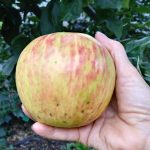Are Those Freckles?
October 18, 2019
Not Freckles. Dimples? Not dimples. Bitter pit. It’s a bothersome disorder, common in  Honeycrisp apples. In the cells of this apple, there is more air space and more pores than in normal apples. The pits are manifestations of clumps of dead cells. The scanned photo of an apple shows fewer veins in the calyx (bottom) of Honeycrisp, which is why bitter pit tends to show up near the bottom.
Honeycrisp apples. In the cells of this apple, there is more air space and more pores than in normal apples. The pits are manifestations of clumps of dead cells. The scanned photo of an apple shows fewer veins in the calyx (bottom) of Honeycrisp, which is why bitter pit tends to show up near the bottom.
Lee Kalcsitis, WSU Assistant Professor, Tree Fruit Physiology, writes: Honeycrisp naturally have bigger cells than most apples. That seems to predispose them to structural degradation associated with bitter pit. And trees that have access to extra water allow those cells to grow even bigger, while limited water during the later stages of fruit growth can keep the fruit cells a little smaller and more stable.
Sat Nov 2, 10-12, Work Party
Sun Nov 17, 2-4, Work Party
Sat Dec 7, 10-12, Work Party
Calcium binds up pectins which translates to the glue that holds the cells together. That glue helps to resist bitter pit but it breaks down as the apples mature. The glue breaks down faster in fruit with less calcium.
 However, calcium is one of the most immobile nutrients. When leaves pull up water from the roots, calcium also travels up. Since the leaves transpire more water than fruit, they get the bulk of the calcium. (Cork spot in pears and tomato end rot have the same issue in that the calcium may be in the soil but it’s not necessarily in the fruit tissue where it is needed.)
However, calcium is one of the most immobile nutrients. When leaves pull up water from the roots, calcium also travels up. Since the leaves transpire more water than fruit, they get the bulk of the calcium. (Cork spot in pears and tomato end rot have the same issue in that the calcium may be in the soil but it’s not necessarily in the fruit tissue where it is needed.)
The strategy for commercial growers is to withhold water, without stressing the tree, and apply calcium sprays. Still, results of these techniques are highly varied. Crop load is also an important factor because, if there are a small number of fruit, they will be large and more susceptible to bitter pit. On the other hand, too many apples can cause fewer blooms the following season.
My strategy: eat them when they are ripe! (Storage time increases the pitting.)
Ruth
additional resources:
Calcium Absorption during Fruit Development in ‘Honeycrisp’ Apple Measured Using 44Ca as a Stable Isotope Tracer. L Kalcsits, G van der Heijden, M Reid, K Mullin – HortScience, 2017
Advanced sensing techniques for analysis of elemental concentrations associated with bitter pit in apple. Zúñiga CE, Jarolmasjed S, Kalcsits LA, Sinhal R, Zhang C, Dhingra A, Sankaran S*. 2017. Postharvest Biology and Technology 128, 121-129.

Thanks, Ruth!